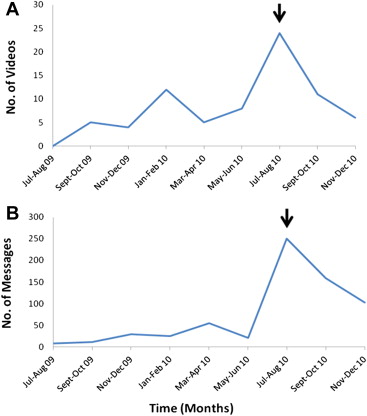Although celebrity illnesses attract a significant amount of media attention in the United States, there are few studies that have looked at how celebrity health conditions impact the awareness of the illness in the general population. Recently, Vice President Cheney underwent left ventricular assist device (LVAD) implantation and subsequently a cardiac transplant. The aim of this study was to determine whether there was evidence of increased interest in these 2 procedures as assessed by social media. We determined the relative frequency of Google searches for LVAD and heart transplantation from 2004 to 2013 using Google trends. We also counted the number of YouTube videos and Twitter messages posted monthly concerning LVADs over a 7-year time frame. There was a significant spike in the Google search interest for LVAD and heart transplantation in the month when Vice President Cheney underwent the respective procedure. Similarly, there was a large increase in YouTube videos and Twitter messages concerning LVADs shortly after he was implanted. In total, these data support the concept that a public figure’s illness can significantly influence the public’s interest in that condition and its associated therapies.
Celebrity illnesses attract a significant amount of media attention in the United States. However, few studies have looked at how celebrity health conditions impact the awareness and perception of the illness in the general population. Recently, former Vice President Richard Cheney underwent implantation of a left ventricular assist device (LVAD), an emerging technology for patients with advanced heart failure, and subsequently a cardiac transplant. Whether these events influenced the public awareness of these therapies is unknown. To address this question, we assessed the temporal trends in interest for these advanced heart failure therapies among users on popular Internet resources such as Google search, YouTube, and Twitter.
Methods
We used search terms “LVAD” and “Heart Transplant” on the Google trends tool (google.com/trends) to obtain a temporal interest plot from 2004 to 2013. As a positive control, we also conducted Google trends searches for other health conditions, which affected well-known celebrities. These included “BRCA Breast Cancer” in Angelina Jolie, “Pulmonary Embolism” in Serena Williams, “Bipolar Disorder” in Catherine Zeta Jones, “Sjogren Syndrome” in Venus Williams, “and “Multiple Sclerosis” in Jack Osborne.
YouTube ( www.youtube.com ) was searched by 2 independent viewers, using the keywords “LVAD” on August 13, 2013, for videos containing pertinent information about LVAD. A similar search was also performed on Twitter, using the keyword “LVAD” for LVAD-related messages that have been posted on the website. Number of videos and messages posted each month in the past 7 years was recorded and plotted in a distribution plot to assess their temporal trends. Inter-rater reliability was assessed using kappa coefficient of agreement.
Results
We observed a significant spike in the search interest for “LVAD” in July 2010 and “Heart Transplant” in March 2012, the months when Vice President Cheney underwent LVAD implantation and heart transplant, respectively ( Figure 1 ). These findings suggest that the use of advanced heart failure therapies in Vice President Cheney significantly influenced public interest in these treatment modalities. In addition, there has been a gradual uptrend in the Google search interest curve for LVAD since 2011, correlating with an increasing frequency of LVAD implantations.

We also observed a similar spike in search interest for other illnesses coinciding with the time of their diagnosis in respective public figures (representative examples shown in Figure 1 ), confirming the findings seen with Vice President Cheney and heart failure therapies. However, despite the impact of Vice President Cheney on general public interest in advanced heart failure therapies, the relative search interest was significantly lower than that for other common cardiac conditions like heart failure and heart attack ( Figure 1 ), providing a frame of reference for the magnitude of the effect.
On YouTube and Twitter data analysis, the kappa coefficient of agreement for identifying relevant videos and messages was 0.97. We again observed a significant spike in the number of LVAD-related videos and messages posted on YouTube and Twitter, respectively, around the time when Vice President Cheney underwent LVAD implantation, confirming his influence on public interest in treatment modalities for advanced heart failure ( Figure 2 ).





